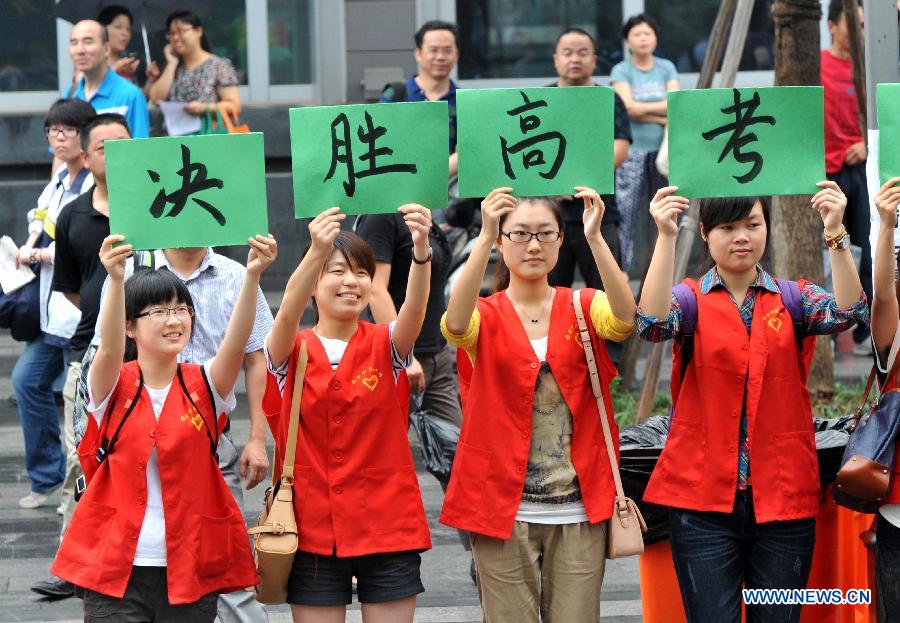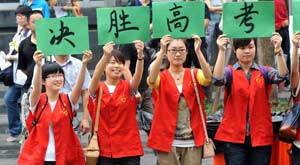Education Alternatives as China Sits gaokao
Xinhua News Agency, June 8, 2012 Adjust font size:
When Qi Qi, a 17-year-old Shanghainese girl, found out she had been accepted by a US university for the coming academic year, social networking websites proved essential in passing on the good news to her former classmates.
As a high school kid in New Jersey, in the United States, who is soon to be a university student in the same country, Qi is among a fast-growing group sidestepping China's national college entrance exam.
The test also known as the gaokao is being held across the country from Thursday to Saturday. Millions of youngsters are hoping to pass it and qualify for further education in China. But many like Qi opt instead for study abroad, often qualifying through a range of foreign pre-university examinations, or to pursue alternative domestic education.
gaokao authorities have seen four consecutive years of dwindling registrants since 2008, when the figure was 10.5 million. In 2012, it is 9.15 million. Three and a half decades after China resumed the exam in the wake of the 10-year Cultural Revolution, Chinese are reassessing how essential it is in defining their futures.
"Single-log bridge" widens
"It is not a choice of following the crowds, but a deliberate decision to offer her a 'different way' with a reputable foreign university degree and colorful life experience," says Qi Qi's mother, Tang Bing.
Tang herself took the gaokao in the early 1980s. The exam has since come to be known as the "single-log bridge" to a Chinese university seat, many examinees viewing it as a "life-or-death" moment -- a single chance to escape lives of limited means.
However, increasing affluence has freed many from this pressure, as noted by Henry Chang, president of the Chinese Educational Development and Cooperation Association (CEDCA). "The greatly improved financial situation of the average Chinese family plus the exchange rate factor make study abroad more affordable," he says.
It was once a prestige choice for rich parents to send their kids to foreign universities for "gold-gilding." Now, parents and students are more concerned with the practical effects, according to Chang. Can the international experience enrich them as people? Will it make them more competitive on the job market?
CEDCA research shows that the number of high schoolers in Shanghai who pursue overseas higher education leapt 30 to 40 percent from 2011 to 2012.
And around 40 percent of those who go to foreign universities come back to work in China, the stats indicate.
These trends are playing out not just in Shanghai. In northeast China's Liaoning Province, all 60 members of the international section of the Liaoning Provincial Experimental High School have received offers from foreign universities.
The 60 are a first batch of scholars to have gone through a new program designed to win them places at foreign universities. They have targeted qualifications accepted by institutions abroad, taken intensive English-language classes and learned about foreign social customs.
"It has been such an odyssey to adjust our ways of thinking and how we learn in the past three years," says Yang Jia, one of the students. "But whenever I thought about the Nobel Prize laureates who often teach undergraduates in the United States, I was inspired."
In Liaoning, about 12,000 people obtained student visas for the United States in 2011, a 70-percent increase year on year.
Comparatively speaking, 250,000 people registered for the exam in the province in 2011, 5,000 and 28,000 fewer than in 2010 and 2009, respectively.
Industry demands skills
While overseas study is mostly reserved for urban students from wealthier families, vocational education within China is also proving popular.
Also in Liaoning, recognized as one of China's major industrial bases, demand for skilled workers is inspiring youngsters to gain more practical qualifications.
"Parents and students are becoming more employment-oriented," says Jin Chunlin, head of enrollment at the Liaoning Technical College of Equipment Manufacturing (LTCEM).
In the past three years, 93 to 96 percent of graduates from this vocational school have gone straight into employment, with their wages exceeding the average for the province. Enterprises such as the Haier Group or car manufacturers provide many of the jobs.
According to Wang Guan, an LTCEM student majoring in equipment maintenance, some of his classmates turned down university offers to come to the school.
"I never feel overshadowed in front of other college students," he adds. "This is a short-cut with one year saved and a higher salary."
While there are clearly more choices for students, it is notable that the high school graduates moving on to study abroad are mostly from China's cities, home to wealthier families and more opportunities than rural areas. For most in the vast countryside of China, the gaokao status quo remains -- at least for now.
"China is in urgent need of a more humanized and fair policy to secure education rights for all," notes Yu Hai, a professor with Fudan University's department of sociology.



